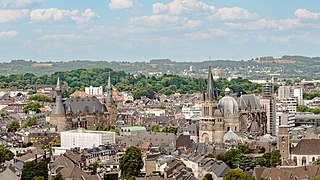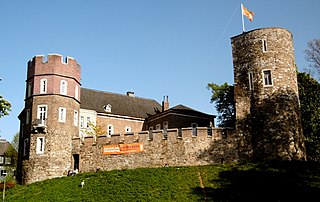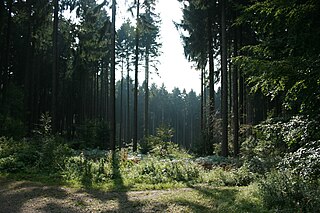
Burtscheid (Latin : Porcetum) is a district of the city of Aachen, part of the Aachen-Mitte Stadtbezirk. It is a health resort.

Burtscheid (Latin : Porcetum) is a district of the city of Aachen, part of the Aachen-Mitte Stadtbezirk. It is a health resort.
It was inhabited since ancient times by Celts and Romans, who were attracted by the presence of hot springs.
Burtscheid Abbey was founded there in 997 by emperor Otto III, with Gregor von Burtscheid as its first abbot. It was finished in 1016–1018.
From 1816 Burtscheid was the administrative capital of the district of Aachen. In 1897 Burtscheid became part of the city of Aachen. [1]
During World War II, the German Nazis established and operated a forced labour camp in the district. [2]

Aachen is the 13th-largest city in North Rhine-Westphalia and the 27th-largest city of Germany, with around 261,000 inhabitants.
The district of Aachen is a district in the west of North Rhine-Westphalia, Germany. Neighboring districts are Heinsberg, Düren, Euskirchen, and also the Netherlands province of Limburg and the Belgian province of Liège. Its administrative body is the Städteregionsparlament, headed by the Städteregionspräsident or "region president".
Euskirchen is a Kreis (district) in the south-west of North Rhine-Westphalia, Germany. Neighboring districts are Aachen, Düren, Rhein-Erft-Kreis, Rhein-Sieg, Ahrweiler, Daun, Bitburg-Prüm, and the Liège province (Belgium).

Eschweiler is a municipality in the district of Aachen in North Rhine-Westphalia in Germany on the river Inde, near the German-Belgian-Dutch border, and about 15 kilometres (9 mi) east of Aachen and 50 kilometres (31 mi) west of Cologne.

Burtscheid Abbey was a Benedictine monastery, after 1220 a Cistercian nunnery, located at Burtscheid, near Aachen, North Rhine-Westphalia, in Germany.

Johann Joseph Couven was a German Baroque architect. He was born in Aachen, where he also died. His legacy includes several religious and secular buildings in Germany, Belgium and the Netherlands.

Kornelimünster Abbey, also known as Abbey of the Abbot Saint Benedict of Aniane and Pope Cornelius, is a Benedictine monastery that has been integrated since 1972. The abbey is located in Aachen in North Rhine-Westphalia in Germany.

Burtscheid is an Ortsgemeinde – a municipality belonging to a Verbandsgemeinde, a kind of collective municipality – in the Bernkastel-Wittlich district in Rhineland-Palatinate, Germany.

Egidius Jünger, also spelled AegidiusJünger, was a German-born prelate of the Roman Catholic Church. He served as bishop of the Diocese of Nesqually in the Washington Territory in the United States from 1879 until his death in 1895.

The Aachen tramway network was the backbone of public transport in Aachen, now in the federal state of North Rhine-Westphalia, Germany, and the surrounding areas from 1880 to 1974. The track gauge was 1,000 mm, see Nordrhein-Westfalen.

The Aachen Bismarck Tower is one of 173 still-standing towers and columns, which were constructed in the German Empire to commemorate the founder of the German state, Otto von Bismarck (1815-1898).
Gregor von Burtscheid, also known as Gregor von Calabria or Gregory of Cassano, was the first abbot of the Burtscheid Abbey, founded on the order of Otto III, Emperor of the Holy Roman Empire.
Aachen-Mitte is one of the seven boroughs of the city of Aachen, Germany, and contains the quarters of Beverau, Bildchen, Burtscheid, Forst, Frankenberg, Grüne Eiche, Hörn, Lintert, Pontviertel, Preuswald, Ronheide, Rothe Erde, Stadtmitte, Steinebrück and West.

The Frankenberg Castle is a castle in the Frankenberg area of Aachen-Mitte, itself a district of Aachen, Germany. Its name comes from the concept of a "Franke", which was a type of castle that did not owe fealty to any others. Of course, shortly after its construction, the lowland castle became a fief of a Graf, and later belonged to the Duchy of Jülich-Cleves-Berg.
The following is a timeline of the history of the city of Aachen, Germany.

Rudolf Paul Maria Henke is a physician and politician of the Christian Democratic Union (CDU) who served as a member of the German Bundestag from 2009 until 2021.

Aachen Forest lies about 3.7 km south of the city centre of Aachen and has an area of 2,357 ha. It essentially comprises the forest areas of the former free imperial city of Aachen south and west of the formerly independent municipalities of Burtscheid and Forst, as well as north and east of the Belgian border. Apart from a few small plots, it is all in municipal ownership. In July 2003, the Forest of Aachen was awarded the environmental seal of the Forest Stewardship Council (FSC) on the initiative of Greenpeace, which was extended in 2008 for another five years.

The Antoniusstraße is one of the oldest streets of in the centre of Aachen, North Rhine-Westphalia, Germany. It is known for window prostitution.

The Aachener Thermalquellen, also known as the Thermal Springs of Aachen and Burtscheid, are a system of more than 30 thermal mineral springs located in the area around Aachen (Aix-la-Chapelle), Germany. The area has been known for its hot sulfur springs for thousands of years.
50°45′56″N6°06′44″E / 50.76556°N 6.11222°E